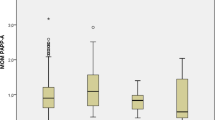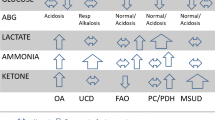Abstract
Background
Acute kidney injury (AKI) is common and is associated with poor clinical outcomes in premature neonates. Urine biomarkers hold the promise to improve our understanding and care of patients with kidney disease. Because kidney maturation and gender can impact urine biomarker values in extremely low gestational age neonates (ELGANs), careful control of gestational age (GA) and time is critical to any urine biomarker studies in neonates.
Methods
To improve our understanding of the potential use of urine biomarkers to detect AKI during the first postnatal weeks, we performed a nested case–control study to evaluate 21 candidate urine AKI biomarkers. Cases include 20 ELGANs with severe AKI. Each case was matched with 2 controls for the same GA week (rounded down to the nearest week), gender, and birth weight (BW) (± 50 g).
Results
Urine cystatin C, creatinine, ghrelin, fibroblast growth factor-23 (FGF23), tissue metalloproteinase 2 (TIMP2) and vascular endothelial growth factor A (VEGFa) concentrations were higher in ELGANs with early severe AKI compared to matched control subjects without AKI. Urine epidermal growth factor (EGF) and uromodulin (UMOD) concentrations are lower in cases than controls. Interleukin (IL)-15 was lower on day 1, but higher on day 8 in cases than controls; while VEGFa was lower on day 1, but higher on day 5 in cases than controls.
Conclusion
Urine biomarkers hold the promise to improve our ability to reliably detect kidney injury. Interventional studies are needed to determine the biomarkers’ ability to predict outcomes, enhance AKI phenotypes, and improve timely interventions which can prevent the sequalae of AKI in ELGANs.
Graphical abstract
A higher resolution version of the Graphical abstract is available as Supplementary information







Similar content being viewed by others
References
Askenazi DJ, Heagerty PJ, Schmicker RH, Griffin R, Brophy P, Juul SE, Mayock DE, Goldstein SL, Hingorani S, PENUT Consortium (2020) Prevalence of acute kidney injury (AKI) in extremely low gestational age neonates (ELGAN). Pediatr Nephrol 35:1737–1748
Hingorani S, Schmicker RH, Brophy PD, Heagerty PJ, Juul SE, Goldstein SL, Askenazi D, PENUT Investigators (2021) Severe acute kidney injury and mortality in extremely low gestational age neonates. Clin J Am Soc Nephrol 16:862–869
Unal ET, Ozer EA, Kahramaner Z, Erdemir A, Cosar H, Sutcuoglu S (2020) Value of urinary kidney injury molecule-1 levels in predicting acute kidney injury in very low birth weight preterm infants. J Int Med Res 48:300060520977442
Jung YH, Han D, Shin SH, Kim EK, Kim HS (2020) Proteomic identification of early urinary-biomarkers of acute kidney injury in preterm infants. Sci Rep 10:4057
Ahn YH, Lee J, Chun J, Jun YH, Sung TJ (2020) Urine biomarkers for monitoring acute kidney injury in premature infants. Kidney Res Clin Pract 39:284–294
Stojanović VD, Barišić NA, Radovanović TD, Kovač NB, Djuran JD, Antić APE, Doronjski AD (2018) Serum glutathione S-transferase Pi as predictor of the outcome and acute kidney injury in premature newborns. Pediatr Nephrol 33:1251–1256
Sellmer A, Bech BH, Bjerre JV, Schmidt MR, Hjortdal VE, Esberg G, Rittig S, Henriksen TB (2017) Urinary neutrophil gelatinase-associated lipocalin in the evaluation of patent ductus arteriosus and AKI in very preterm neonates: a cohort study. BMC Pediatr 17:7
Mercier K, McRitchie S, Pathmasiri W, Novokhatny A, Koralkar R, Askenazi D, Brophy PD, Sumner S (2017) Preterm neonatal urinary renal developmental and acute kidney injury metabolomic profiling: an exploratory study. Pediatr Nephrol 32:151–161
Elmas AT, Karadag A, Tabel Y, Ozdemir R, Otlu G (2017) Analysis of urine biomarkers for early determination of acute kidney injury in non-septic and non-asphyxiated critically ill preterm neonates. J Matern Fetal Neonatal Med 30:302–308
Jansen D, Peters E, Heemskerk S, Koster-Kamphuis L, Bouw MP, Roelofs HM, van Oeveren W, van Heijst AF, Pickkers P (2016) Tubular injury biomarkers to detect gentamicin-induced acute kidney injury in the neonatal intensive care unit. Am J Perinatol 33:180–187
Hanna M, Brophy PD, Giannone PJ, Joshi MS, Bauer JA, RamachandraRao S (2016) Early urinary biomarkers of acute kidney injury in preterm infants. Pediatr Res 80:218–223
Askenazi DJ, Koralkar R, Patil N, Halloran B, Ambalavanan N, Griffin R (2016) Acute kidney injury urine biomarkers in very low-birth-weight infants. Clin J Am Soc Nephrol 11:1527–1535
Tabel Y, Elmas A, Ipek S, Karadag A, Elmas O, Ozyalin F (2014) Urinary neutrophil gelatinase-associated lipocalin as an early biomarker for prediction of acute kidney injury in preterm infants. Am J Perinatol 31:167–174
Lavery AP, Meinzen-Derr JK, Anderson E, Ma Q, Bennett MR, Devarajan P, Schibler KR (2008) Urinary NGAL in premature infants. Pediatr Res 64:423–428
Askenazi DJ, Halloran BA, Heagerty PJ, Schmicker RH, Brophy P, Juul SE, Hingorani S, Goldstein SL, PENUT Trial Consortium (2021) Gestational age, sex, and time affect urine biomarker concentrations in extremely low gestational age neonates. Pediatr Res. https://doi.org/10.1038/s41390-021-01814-x
Juul SE, Mayock DE, Comstock BA, Heagerty PJ (2015) Neuroprotective potential of erythropoietin in neonates; design of a randomized trial. Matern Health Neonatol Perinatol 1:27
Juul SE, Comstock BA, Wadhawan R, Mayock DE, Courtney SE, Robinson T, Ahmad KA, Bendel-Stenzel E, Baserga M, LaGamma EF, Downey LC, Rao R, Fahim N, Lampland A, Frantz Iii ID, Khan JY, Weiss M, Gilmore MM, Ohls RK, Srinivasan N, Perez JE, McKay V, Vu PT, Lowe J, Kuban K, O’Shea TM, Hartman AL, Heagerty PJ, PENUT Trial Consortium (2020) a randomized trial of erythropoietin for neuroprotection in preterm infants. N Engl J Med 382:233–243
Kellum JA, Lameire N, KDIGO AKI Guideline Work Group (2013) Diagnosis, evaluation, and management of acute kidney injury: a KDIGO summary (Part 1). Crit Care 17:204
Askenazi DJ, Koralkar R, Levitan EB, Goldstein SL, Devarajan P, Khandrika S, Mehta RL, Ambalavanan N (2011) Baseline values of candidate urine acute kidney injury biomarkers vary by gestational age in premature infants. Pediatr Res 70:302–306
Goodpaster AM, Ramadas EH, Kennedy MA (2011) Potential effect of diaper and cotton ball contamination on NMR- and LC/MS-based metabonomics studies of urine from newborn babies. Anal Chem 83:896–902
Boohaker L, Halloran B, Wilson L, Berryhill T, Barnes S, Griffin R, Askenazi D (2019) Absorbent materials to collect urine can affect proteomics and metabolomic biomarker concentrations. Clin Chem Lab Med 57:e134–e137
Funding
The Recombinant Erythropoietin for Protection of Infant Renal Disease (REPaIReD) Study is an NIH NIDDK funded (R01 DK103608) ancillary study designed to look at kidney outcome in patients enrolled in the Preterm Erythropoietin Neuroprotection Trial (PENUT trial) which is an NIH NINDS funded (U01 NS077953, U01 NS077955) trial. Urine creatinine was run at the UAB AKI O’Brien Center core (NIH P30-DK079337). The clinicaltrials.gov identifier is NCT01378273.
Author information
Authors and Affiliations
Consortia
Contributions
DA contributed to the conceptualization and design of the study, data analysis, and drafted the initial manuscript. BH, RS, PH, SJ, SH, and SG contributed to the conceptualization and design of the study, data analysis and assisted in the manuscript preparation. All authors approved the final manuscript as submitted and agree to be accountable for all aspects of the work.
Corresponding author
Ethics declarations
Disclaimer
Funding sources for this study had no role in study design, data collection, data analysis, data interpretation, or writing of the report.
Consent statement
Parental/guardian consent was required for participation.
Conflict of interest
All authors declare no real or perceived conflicts of interest that could affect the study design, collection, analyses, and interpretation of data, writing of the report, or the decision to submit for publication. For full disclosure, we provide here an additional list of authors’ commitments and funding sources that are not directly related to this study:
Dr. Askenazi is a consultant for Baxter, Nuwellis. Medtronic, BioPorto, and SeaStar. His institution receives external education and research funding not related to this project from Baxter, Nuwellis, Medtronic, Seastar, and Bioporto. He has patents pending for inventions in the neonatal nephology field. He is Chief Scientific Officer of Zorro-Flow Inc.
Dr. Goldstein reports personal fees from and a position and as a consultant to Nuwellis, Renibus, ExThera, Reata, and Medtronic Inc. Dr. Goldstein receives grant funding from and serves as a consultant and on a Speaker’s Bureau for Baxter Healthcare, Inc. Dr. Goldstein receives grant funding and serves as a consultant for BioPorto, Inc. Dr. Goldstein serves on a Speaker’s Bureau for Fresenius Medical Corporation. Dr. Juul receives grant funding from NINDS and NICHD for studies not related to this project. Dr. Heagerty and Mr. Schmicker receive grant funding from NIH and PCORI for studies not related to this project.
Additional information
Publisher's note
Springer Nature remains neutral with regard to jurisdictional claims in published maps and institutional affiliations.
Some data presented in this study were previously presented as an e-poster abstract presentation at the 2021 American Society of Nephrology meeting.
Supplementary Information
Below is the link to the electronic supplementary material.
Rights and permissions
About this article
Cite this article
Askenazi, D.J., Halloran, B.A., Heagerty, P.J. et al. Urine acute kidney injury biomarkers in extremely low gestational age neonates: a nested case control study of 21 candidate urine biomarkers. Pediatr Nephrol 38, 1329–1342 (2023). https://doi.org/10.1007/s00467-022-05688-x
Received:
Revised:
Accepted:
Published:
Issue Date:
DOI: https://doi.org/10.1007/s00467-022-05688-x




